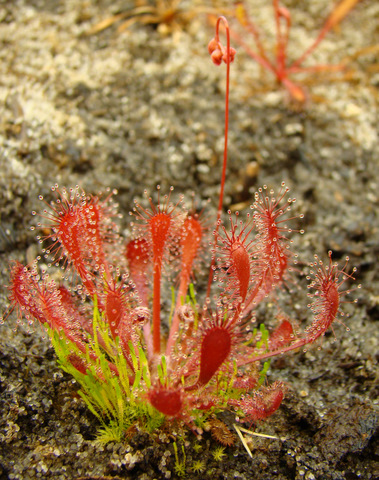What is a Sundew?
How Sundews Move Their Leaves and Tentacles around prey
While my knowledge of this process is limited, I will describe some of the basic information that has been published about the tentacle and leaf movement of Drosera. First, there have been several studies that tested the detection of molecules or ions by the tentacles of sundews in the absence of any major tentacle disturbance (physical stimulation). Darwin tested nitrates on the tentacles of sundew leaves and discovered the leaves moved in the abcense of tentacle disturbance. Different minerals also produce this response. While I haven't gone about testing different types of minerals, you can get a very fast response when adding a dilute solutions of potassium chloride, for example. It is likely that the sundew has different levels of detection depending on the mineral type, but I haven't looked into this. The minimal concentration needed to stimulate a response by the tentacles and leaves has been determined for nitrogen, and can easily be determined for other minerals by preparing different dilute concentrations of mineral solutions.
Chitinases are digestive enzymes produced by sundews, which are used to break down the exoskeleton of insects (which is comprised of chitin). When I placed a small amount of pure hydrated chitin (isolated from crab shells and softened in Deionized distilled water) gently onto the mucilage while avoiding disturbance of the tentacles, the tentacles and leaf curls dramatically, and the chitin was digested completely within a few days. Chitinases are able to cleave bonds between different portions of the chitin chains, providing the sundew with a good source of nitrogen.
Sundews also have the capability to detect and digest of proteins and fatty acids. Breakdown of proteins is carried out by proteases that are also produced by the sundew. While I haven't done this myself, I think by that adding pure amino acids or a purified protein to the mucilage (such as albumin, a very commonly available protein), the leaf should respond. There's likely a paper on that somewhere doing something of the sort, but I haven't been able to find that yet.
And then there's the actual mechanism for leaf/tentacle movement. While it isn't totally identified yet, the most commonly accepted method for the venus flytrap closure mechanism consists of the following:
1. An action potential is sent by the trigger hair to the cells at the base of the leaf.
2. The action potential causes ions to rush down a gradient into the cells at the base of the leaf, leading to an instant and rapid uptake water due to turgor pressure changes.
This process is very similar to the closure and opening of the stomata, which can occur at incredibly fast speeds.
For sundews, the mechanism may be similar to venus flytraps, but it is likely a bit more complex, since the leaf can bend in very different directions depending on the size and shape of the food, as well as where it's positioned on the leaf. Some people originally proposed that the backside of the leaf might actually be growing rapidly via auxins, but that does not appear to be the case, since the leaf can return to its original size and shape after it folds over a meal and "relaxes" back to its "resting" state.
Disclaimer: More info to come about tentacle/leaf movement when I have time to site my references and link the pages...In the meantime I apologize for any innacuracies, as I'm doing this all by memory at this point.
Works Cited
Barthlott, Wilhelm et.al. The Curious World of Carnivorous Plants. Portland: Timber Press, 2007.
Additional Questions or Suggestions?
Contact me at: sundewman(at)yahoo.com
